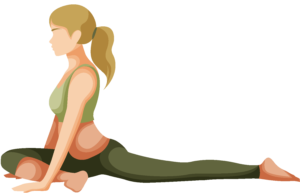Pigeon (Kapotasana)
Pose Overview
| Common Name | Pigeon |
| Traditional Sanskrit Name | Kapotasana |
| Sanskrit Name Pronunciation | kah-poh-tahs-ana |
| Pose Difficulty | Intermediate |
| Drishti
Drishti is the gaze or visual focus point during yoga poses.
Learn more about Drishti |
Upward, towards the sky |
Pigeon Pose, also known as Eka Pada Rajakapotasana, is a deep hip opener that is often used in vinyasa, power, and ashtanga yoga classes. The pose is named after the shape of the body in the final position, which resembles a pigeon. The pose is considered to be an intermediate level pose, as it requires a good amount of flexibility in the hips, legs, and back.
Benefits of Pigeon
Opens the hips and releases tension in the lower back Stretches the hip flexors, glutes, and psoas muscle Improves balance and stability Enhances the flexibility of the spine Improves the digestion
How to Enter Pigeon
Start in a low lunge position with your right foot forward and your left knee on the ground Slowly bring your left knee towards your right hand and place your left ankle near your right hip Slowly lower your hips towards the ground, keeping your right knee close to your right hand Hold onto your right foot with your right hand and extend your left arm towards the sky
How to Exit Pigeon
Slowly lift your hips off the ground and release your foot from your hand Bring your left knee back to the ground and step your left foot forward to return to a low lunge position Repeat on the other side
Common Pigeon Modifications & Variations
If you are unable to reach your foot, you can use a strap around your foot to help you hold onto it If your hips are tight, you can place a blanket or cushion under your hips for support
Common Mistakes with Pigeon
Not keeping the hip of the back leg facing forward, which can cause strain on the knee Not keeping the front knee behind the ankle, which can cause strain on the knee Not keeping the front heel inline with the front knee
Safety Guidance
Pigeon pose is not recommended for individuals with knee or lower back injuries If you have any pain or discomfort in your knee, ankle or back, stop the pose and come out of it Keep your knee inline with your ankle and keep your ankle close to your knee

